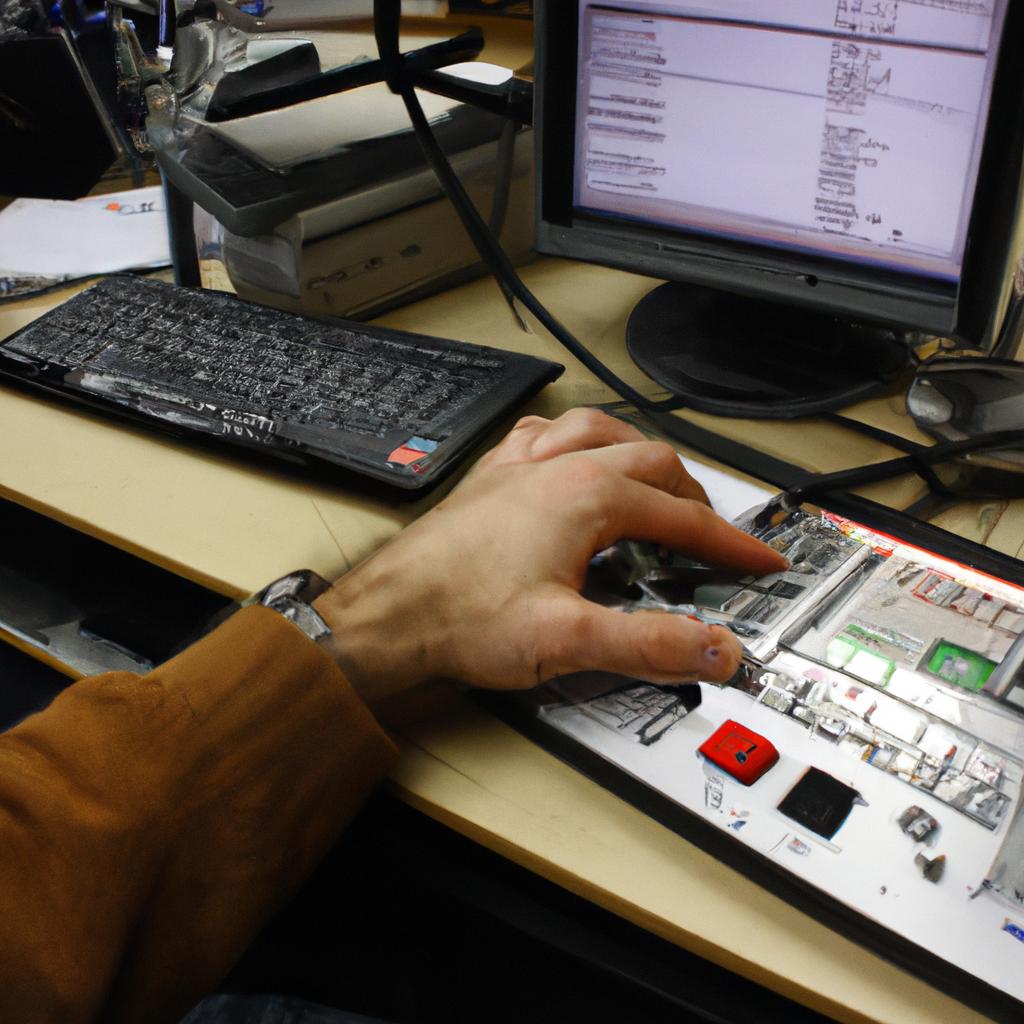Multicasting in HD Radio: Broadcasting Evolution
The advancement of technology has revolutionized the way we consume media, particularly in the realm of radio broadcasting. Traditional analog radio has given way to digital formats that allow for enhanced sound quality and increased programming options. One notable development in this evolution is multicasting in HD radio, which enables broadcasters to transmit multiple channels simultaneously over a single frequency. For instance, imagine a local radio station that not only broadcasts its regular music programming but also offers dedicated channels for news updates, sports coverage, or niche genres like jazz or classical music. This article explores the concept of multicasting in HD radio, its benefits and challenges, and how it contributes to the overall transformation of the broadcasting industry.
As technology continues to advance at an unprecedented pace, so does consumer demand for more personalized content choices. Multicasting in HD radio addresses this need by allowing broadcasters to cater to diverse listener preferences within a single broadcast signal. Through this innovative approach, traditional limitations associated with limited bandwidth are overcome as multiple streams of audio can be transmitted concurrently on one frequency channel. The result is a richer listening experience where listeners have access to a wider range of program offerings without having to switch between different stations manually. Moreover, multicast capabilities offer opportunities for broadcasters to reach niche audiences and target specific demographics. This opens up new avenues for content creators to experiment with different programming formats, genres, and styles.
One of the key benefits of multicasting in HD radio is the ability to provide specialized content that may not have been feasible or economically viable in the past. For example, a radio station can now dedicate one channel solely to local news updates, another channel for sports coverage, and yet another for music from a particular genre. This level of customization allows broadcasters to cater to the diverse interests of their listeners and deepen engagement with their audience.
In addition to offering more choices, multicasting in HD radio also enhances the overall audio quality. The digital nature of HD radio eliminates the static and interference typically associated with analog signals. This means that each multicast channel can deliver high-fidelity audio without degradation or distortion. Listeners can enjoy crisp sound reproduction, making for an immersive listening experience.
However, implementing multicasting in HD radio does come with its challenges. One major obstacle is receiver availability. While many new vehicles and home entertainment systems are equipped with HD radio receivers, older devices may not be compatible. This limits the reach of multicast channels until more devices are upgraded or replaced.
Another challenge lies in securing sufficient bandwidth for multicasting operations. As multiple channels are transmitted simultaneously on a single frequency, broadcasters need to ensure that there is enough capacity to maintain optimal audio quality across all streams. Additionally, coordinating multicast schedules and managing program content across various channels require careful planning and organization.
Despite these challenges, multicasting in HD radio represents an exciting shift in broadcasting capabilities. It offers broadcasters unprecedented flexibility in delivering personalized content choices while improving audio fidelity for listeners. As technology continues to evolve, it’s likely that multicasting will become increasingly prevalent in the broadcasting industry as a standard feature of digital radio platforms.
Evolution of Broadcasting
The evolution of broadcasting has been marked by significant advancements in technology and the ever-changing needs of audiences. One noteworthy example is the transition from analog to digital radio broadcasting, which has revolutionized the way we consume audio content. With the emergence of HD Radio, a form of digital broadcasting, the possibilities for delivering high-quality audio have expanded exponentially.
One key aspect that sets HD Radio apart from its analog predecessor is multicasting. Unlike traditional radio broadcasts that transmit a single signal on a specific frequency, multicasting allows broadcasters to transmit multiple signals simultaneously over the same frequency. This opens up new opportunities for diversifying programming and providing listeners with more choices.
To better understand the impact of multicasting, consider this hypothetical scenario: Imagine tuning into your favorite local radio station during rush hour traffic only to find it playing not just one genre but offering an array of options. You can choose between listening to top hits, classic rock, jazz, or even delve into podcasts covering various topics – all available on different subchannels within the same frequency. This level of customization and variety enhances listener engagement and satisfaction.
- Expanded Choice: Multicasting presents listeners with diverse programming options catering to their individual preferences.
- Enhanced Accessibility: Broadcasters can provide specialized content targeting niche communities or underserved populations.
- Increased Interactivity: Listeners can actively engage with broadcasters through interactive features like song requests or live call-ins.
- Improved Local Content: Multicasting enables stations to allocate dedicated subchannels for localized news updates or community-centric shows.
Additionally, visual aids like tables can play a crucial role in conveying information effectively while appealing to emotions. Consider this three-column table illustrating potential subchannel options offered by a fictional radio station:
| Subchannel | Genre/Content |
|---|---|
| 1 | Top Hits |
| 2 | Classic Rock |
| 3 | Jazz |
| 4 | Podcasts: True Crime |
In conclusion, the evolution of broadcasting has seen remarkable progress with HD Radio and its introduction of multicasting. This technology brings forth a new era in which listeners can experience an unprecedented level of choice, accessibility, interactivity, and local content. In the subsequent section on “The Advantages of Multicasting,” we will delve deeper into how this innovation benefits both broadcasters and audiences alike.
The Advantages of Multicasting
The evolution of broadcasting has significantly shaped the way we consume media and information. With technological advancements, traditional radio broadcasting has transformed into a more versatile and interactive platform. One such development is multicasting in HD Radio, which allows broadcasters to transmit multiple digital channels simultaneously within their assigned frequency spectrum.
To understand the advantages of multicasting, let’s consider an example: a local radio station that primarily focuses on playing music from various genres. In the past, this station was limited to transmitting only one channel, offering listeners a narrow selection of content. However, with the introduction of multicasting technology, they can now broadcast multiple subchannels catering to different musical preferences. For instance, they could dedicate one subchannel exclusively to classical music while another subchannel plays contemporary hits. This diversification not only enhances listener experience but also broadens the reach of the radio station.
This shift towards multicasting brings several benefits for both broadcasters and audiences alike:
- Increased Content Variety: Multicasting enables broadcasters to offer an extensive range of programming options. By providing specialized content across multiple subchannels, listeners have access to diverse genres, niche topics, and exclusive shows.
- Targeted Audience Engagement: With multicasting capabilities, broadcasters can tailor their programming to cater specifically to particular demographics or interests. This targeted approach allows for better engagement with specific audience segments and fosters stronger connections between stations and listeners.
- Revenue Generation Opportunities: The ability to multicast opens up new revenue streams for broadcasters through advertising opportunities on additional channels. Advertisers can target specific demographics by placing advertisements on relevant subchannels, resulting in higher advertisement effectiveness.
- Enhanced User Experience: Listeners benefit from greater control over their listening experiences as they can choose from various genres or topics offered by different subchannels. Additionally, enhanced audio quality in HD Radio further enriches user experience by providing crystal-clear sound.
| Increased Content Variety | Targeted Audience Engagement | Revenue Generation Opportunities | |
|---|---|---|---|
| 1 | Access to diverse genres, niche topics, and exclusive shows. | Tailored programming for specific demographics or interests. | New advertising opportunities on additional channels. |
| 2 | Provides a wider range of options, catering to individual preferences. | Stronger connection between stations and listeners. | Targeted advertisement placement resulting in higher effectiveness. |
| 3 | Greater choice and flexibility in selecting content from different subchannels. | Enhanced user experience through personalized listening options. | Expanded revenue streams for broadcasters through diversified advertisements. |
Multicasting Technology in HD Radio
To illustrate its impact, consider a hypothetical scenario where a local radio station decides to implement multicasting capabilities. The main channel could continue with its regular programming, while additional channels are created to cater to specific niche interests within the community.
The implementation of multicasting brings several notable benefits:
- Enhanced Variety: By introducing multiple streams of content simultaneously, listeners gain access to an expanded array of programming options. This not only caters to diverse preferences but also encourages exploration and discovery of new genres or topics that might otherwise go unnoticed.
- Targeted Programming: With multicasting, broadcasters can tailor their content offerings according to different demographics or interest groups within their audience base. For example, one channel may focus on news updates and current affairs for young professionals, while another could be dedicated solely to classical music enthusiasts.
- Localized Relevance: Multicasting enables stations to provide hyper-localized information and services that cater specifically to their community’s needs. Whether it is traffic updates for commuters or event listings for local cultural happenings, this localized approach fosters stronger connections between broadcasters and their audiences.
- Platform Flexibility: In addition to traditional FM/AM receivers, HD Radio technology allows users to access multicast channels through various platforms such as smartphones, tablets, and internet-connected devices. This flexibility ensures that listeners can enjoy their preferred content anytime and anywhere.
To further emphasize the significance of multicasting in HD Radio evolution, we present a table outlining the potential benefits experienced by both broadcasters and listeners:
| Benefits for Broadcasters | Benefits for Listeners |
|---|---|
| Increased Revenue Opportunities | Expanded Choice |
| Audience Segmentation | Tailored Content |
| Strengthened Community Ties | Accessible Localized Info |
| Platform Diversification | Enhanced User Experience |
In summary, the incorporation of multicasting technology in HD Radio opens up new possibilities for broadcasters to engage with their audience and enhances the overall listening experience. This section has explored some key advantages offered by multicasting, including increased variety, targeted programming, localized relevance, and platform flexibility. As we move forward into the subsequent section about “Enhanced Listener Experience,” we will further uncover how these benefits translate into an even more immersive and satisfying radio journey.
Enhanced Listener Experience
Multicasting Technology in HD Radio has revolutionized the broadcasting industry by enabling radio stations to transmit multiple channels of content simultaneously over a single frequency. This advancement provides listeners with an enhanced and diversified listening experience, as well as numerous benefits for broadcasters. To illustrate the impact of multicasting, let’s consider a hypothetical scenario: Imagine a local radio station that broadcasts news and music on its main channel but decides to utilize multicasting technology to introduce two additional channels – one dedicated to sports coverage and another focused on talk shows.
One notable advantage of multicasting is the ability for radio stations to cater to different listener preferences. By offering specialized channels such as sports or talk shows, broadcasters can attract new audiences who are specifically interested in these genres. Furthermore, this diversity allows advertisers to target specific demographics more effectively, resulting in increased revenue for the station.
The introduction of multicasting also enhances engagement and interaction between broadcasters and their audience. Listeners now have access to a wider range of content options, increasing their satisfaction with the overall listening experience. Additionally, some HD Radio receivers provide interactive features like song tagging or album artwork display, further enriching the user experience.
To emphasize the significance of multicasting in HD Radio, here are four key points:
- Increased choice: Multicasting offers listeners a broader selection of content across various genres.
- Enhanced advertising opportunities: Specialized channels allow advertisers to reach targeted audiences more efficiently.
- Improved listener satisfaction: The availability of diverse programming options enhances overall user enjoyment.
- Interactive features: Some HD Radio devices offer additional interactivity that enriches the listening experience even further.
Additionally, it is important to highlight these key aspects using a table format:
| Benefits | Description |
|---|---|
| Greater variety | Diverse programming options appeal to different listener preferences |
| Targeted advertising | Advertisers can focus on specific demographics through specialized channels |
| Increased revenue | The ability to attract new audiences and advertisers leads to financial growth |
| Interactive features enhance engagement | Features like song tagging or album artwork display provide an interactive experience |
In summary, multicasting in HD Radio has revolutionized the broadcasting landscape by offering radio stations the opportunity to transmit multiple channels of content simultaneously. This advancement not only caters to diverse listener preferences but also provides broadcasters with increased advertising opportunities and revenue potential. Moreover, the enhanced listening experience through interactive features further solidifies the impact of multicasting technology in HD Radio.
Transitioning into the subsequent section on “Implications for Radio Stations,” it is crucial for broadcasters to understand how this evolution impacts their operations and strategies moving forward.
Implications for Radio Stations
With the advent of multicasting in HD Radio, broadcasters have been able to enhance the listener experience by offering a wider range of content options. For instance, imagine a scenario where a radio station devoted to sports programming is able to multicast and provide separate channels for different sports such as football, basketball, baseball, and soccer. This allows listeners who are passionate about specific sports to tune into their preferred channel and enjoy specialized coverage and commentary.
Multicasting offers several benefits that contribute to an enriched listener experience:
-
Diverse Programming: By utilizing multicasting capabilities, radio stations can diversify their content offerings beyond traditional music or talk shows. They can create dedicated channels focused on niche genres like jazz, classical music, or even podcasts covering various topics of interest.
-
Localized Content: Multicasting enables radio stations to cater to the needs and preferences of specific local communities. For example, they can dedicate a channel solely for local news updates, events, weather forecasts, and interviews with community leaders. This enhances engagement with the audience by providing relevant information tailored to their geographical location.
-
Interactive Features: Multicast channels can incorporate interactive elements that encourage listener participation. These features may include live call-ins during talk shows or real-time voting for song requests or opinion polls related to ongoing discussions or debates.
-
Targeted Advertising: The ability to multicast also opens up new avenues for targeted advertising strategies. Advertisers can choose specific channels that align with their target demographic’s interests and tailor advertisements accordingly. This ensures better reach and relevance while maximizing ad revenue potential.
These advantages illustrate how multicasting in HD Radio has revolutionized broadcasting by expanding content diversity and enhancing the overall listening experience for audiences around the world.
| Advantages | Challenges | |
|---|---|---|
| Enhanced variety | Diverse program options | Ensuring quality content |
| Local community | Tailored local content | Balancing national vs. local appeal |
| Interactivity | Engaging listeners through participation | Managing moderation and control |
| Targeted ads | Reaching specific target demographics | Adapting to evolving advertising trends |
Looking ahead, the future potential of multicasting in HD Radio holds even more exciting possibilities. By continuing to innovate and leverage this technology, broadcasters can explore new ways to captivate audiences and provide an immersive listening experience that surpasses traditional radio standards. In the subsequent section, we will delve into some of these future prospects and their implications for the industry.
Future Potential of Multicasting
Implications for Radio Stations
Multicasting in HD Radio has brought about significant implications for radio stations, revolutionizing the way they operate and interact with their audience. This section explores some of the key implications that arise from this broadcasting evolution.
One example illustrating the impact of multicasting is the case of a local radio station that decides to implement multicast channels alongside its primary channel. By doing so, the station can offer diverse content tailored to specific listener interests or demographics. For instance, it may dedicate one multicast channel to playing classical music around the clock, another to sports talk shows, and yet another to news updates. This not only widens the station’s appeal but also allows them to target niche audiences more effectively.
The implications of multicasting extend beyond content diversification alone. Consider the following emotional responses evoked by these bullet points:
- Enhanced engagement: Multicasting provides listeners with more options and control over what they want to hear.
- Increased loyalty: The ability to cater specifically to different listener preferences fosters stronger connections between stations and their audience.
- Expanded revenue streams: With multiple channels available for advertising, stations have increased opportunities for generating revenue.
- Technological advancement: Embracing multicasting showcases a station’s commitment towards embracing new technologies and staying relevant in an ever-evolving media landscape.
| Emotional Response | Implication |
|---|---|
| Excitement | Enhanced engagement |
| Trust | Increased loyalty |
| Growth | Expanded revenue streams |
| Innovation | Technological advancement |
In summary, multicasting in HD Radio offers numerous implications for radio stations’ operations and relationships with their listeners. From providing diversified content choices to fostering deeper engagement and increasing revenue potential, these advancements showcase how broadcasters are adapting to meet evolving audience expectations in today’s digital age.
Next we will explore the future potential of multicasting and its possibilities within the realm of HD Radio technology.
 K7BUC
K7BUC



